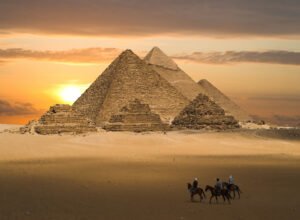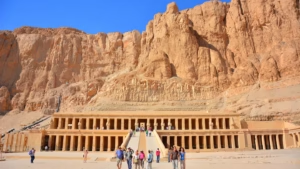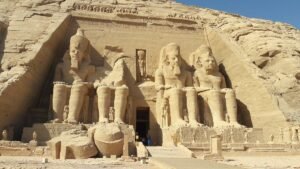


From the moment the Nile slices through dawn’s light, whispering tales older than memory, you feel time in Egypt—not ticking, but layered, luminous, visible. If you’re someone fascinated by how places can hold centuries in stone, sand, and sky, then these are the best places to visit in Egypt. Each is a portal—through architecture, nature, or culture—where you can stand, breathe, and see what it means for time to become visible.
Cairo – Where Centuries Converge
Cairo is the heart of Egypt’s living past. For those seeking the best places to visit in Egypt, Cairo both overwhelms and invites: the contrasts of modern towers, medieval markets, Islamic architecture, Coptic relics, and the looming monuments of the Old Kingdom just beyond its edges.
Giza Plateau and the Great Pyramids
No journey into Egypt’s past is complete without standing before the Great Pyramids of Giza and the Sphinx. Built around 2580–2560 BCE for Pharaoh Khufu (Khnum-Khufu), the Great Pyramid remains one of the Seven Wonders of the Ancient World and the oldest still largely intact. OneVasco+2TimesSquareReporter+2
Walking around the base of the Pyramid, the sense of scale is overwhelming. Stones weighing tons, placed with engineering accuracy that still intrigues modern scholars. At sunrise or sunset, shadows stretch deep, carving the edges of the pyramid sharply, reminding you that time here is both ancient and continuously unfolding.
The Egyptian Museum & New Grand Egyptian Museum
In downtown Cairo, the Egyptian Museum houses tens of thousands of artifacts: mummies, coffins, statues, everyday items from pharaonic lives. Here, the mask of Tutankhamun glows behind glass, sealing in mystery. For visitors who want the best places to visit in Egypt, the museum offers a layered historical narrative: Old Kingdom tombs, the Middle Kingdom, the New Kingdom, the Late Period, Ptolemaic and Roman times.
Soon, the Grand Egyptian Museum (GEM), near the pyramids, aims to become a central point where these layers are presented with modern conservation, displays, and storytelling. TIME+2OneVasco+2
Islamic and Coptic Cairo
Away from pharaohs and pyramids, time shows in faith, in stone carvings and minarets. The citadel of Saladin with the Mosque of Muhammad Ali dominates the skyline; Coptic Cairo hides ancient churches like the Hanging Church and the Ben Ezra Synagogue. Walking alleys where Christians and Muslims built intertwined lives, and where Islamic, Byzantine, and pharaonic pasts coexist, is to see time rendered visible in layered architecture, in mosaic, in prayer.
Luxor and Thebes – Temples, Tombs, and Eternal Light
Luxor (ancient Thebes) is perhaps the clearest place in Egypt to witness how the best places to visit in Egypt show time in visible stone, in the flickering torchlight of tombs, in desert sun flashing across temple columns.
The Valley of the Kings & Queens
On the west bank of the Nile in Luxor lies the Valley of the Kings, where over 60 royal tombs—New Kingdom pharaohs like Seti I, Ramses II, and Tutankhamun—were carved beneath cliffs. Their elaborate paintings and hieroglyphs narrate sacred journeys to the afterlife. Descending into a tomb, the air cools, the smell of ancient stone is everywhere, and you descend not just into earth but into myth, belief, artistry preserved across millennia. One Nation Travel+2cities-magazine.com+2
Karnak Temple Complex and Luxor Temple
Stretching across more than 200 acres, Karnak Temple is a centuries-long construction effort, built, added to, modified, restored by successive pharaohs. Its hypostyle hall, with massive looming columns carved in relief, still channels sunlight through carefully aligned openings. Luxor Temple, nearer the Nile, engraved with scenes of processions, rituals, and royal display, often illuminated at night, glows like a memory made visible. OneVasco+2Encyclopedia Britannica+2
Aswan, Nubia, and Abu Simbel – Time Sculpted by Sun and Stone
In southern Egypt, time takes on a different hue: the desert, the river, the sun overhead, Nubian culture, and temples cut into cliffs—all conspiring to remind you that some places were designed to last, to witness.
Philae Temple
Island-set in the Nile near Aswan, Philae Temple was dedicated to the goddess Isis. Its relocation—moved stone by stone when the Aswan High Dam threatened to submerge it—makes it a monument not only to antiquity but to modern preservation. Boats carry you across shimmering water; granite columns reflect in the rippling Nile; hieroglyphs and reliefs peer into sunlight. Time here is both ancient and rescued. OneVasco+1
H3: Abu Simbel
Farther south, Abu Simbel stands at the edge of rock and horizon. Carved into a mountain under Ramses II, the twin temples were also moved in the 1960s to avoid flooding. Four colossal statues guard the entrance; chambers are precisely aligned so twice a year, sunlight penetrates to the inner sanctum, illuminating the figure of the seated Ramses and the gods beside him. It’s engineering, art, and ritual aligned with cosmos. A place where the best places to visit in Egypt aren’t just seen—they happen. OneVasco+1
Other Temples, Necropolises, and Hidden Places – Layers Off the Beaten Path
Beyond the big names, Egypt has many sites where time is visible in quieter, less crowded spaces. For those who want deeper knowledge, scholarly research, or just moments away from crowds, these are among the best places to visit in Egypt too.
Saqqara Necropolis
South of Cairo lies Saqqara, the necropolis for ancient Memphis. Its Step Pyramid of Djoser (Third Dynasty) is the oldest large-scale stone building in history. Mastabas, tombs of nobles, Serapeum of Apis, etc., show the evolution of Egyptian funerary architecture. Each tomb reveals daily life scenes carved in relief, art styles that shift over centuries. Wikipedia+1
Dendera Temple Complex
In Upper Egypt on the banks of the Nile, Dendera is home to the Temple of Hathor. Extremely well preserved, built during Ptolemaic times and extended during Roman times, it has the famed Dendera Zodiac, “birth houses”, chapels dedicated to Isis, and beautifully painted reliefs. The roof and inner ceilings, astronomical alignments, and artistic motifs are still fresh enough to pierce through time. Wikipedia
Abydos & Temple of Seti I
Abydos is considered sacred ground in Egyptian religion. The Temple of Seti I houses the King List inscriptions (lists of pharaohs) that help historians reconstruct Egypt’s chronology. It contains fine reliefs, insight into rituals, and is intimately tied to myth, especially those concerning Osiris. For anyone studying or researching ancient religion, Abydos is indispensable. OneVasco+1
Edfu and Kom Ombo Temples
Edfu’s Temple of Horus is one of the best spectacularly preserved Ptolemaic temples, with inscriptions in very good condition. Kom Ombo (shared temple to Sobek and Horus) has the unusual double-structure and also reliefs and calendar systems, medical instruments carved in stone, crocodile mummies. These places are less crowded than the “big four” but reveal much about religion, administration, daily life in ancient Egypt. OneVasco
H2: Natural and Desert Landscapes Where Time Echoes
Beyond stone and ritual, the natural world in Egypt also reveals time in subtle and powerful ways. In landscapes shaped by water, sandstorms, shifting dunes, and isolated oases, time becomes visible in shifting light, in eroded rock, in silence.
Siwa Oasis
Far to the west, near the Libyan border, Siwa Oasis is remote, magical. Palm groves, salt lakes, mountain ridges, and unique Berber culture converge. Ancient oracle sites, springs, traditional Siwan architecture: time feels slower, thicker. This is one of the best places to visit in Egypt if you want to feel centuries folding into each step. tripsarena.com
The Western Desert’s White Desert and Black Desert
In the Western Desert, geological time writes itself in chalk formations (White Desert), volcanic rock outcrops (Black Desert), fossil beds, wind-etched sculptures. At dawn or dusk, shadows lengthen across undulating sand and strange stone, and you see ages pass in color and erosion.
The Red Sea Coast & Sinai
The Sinai Peninsula offers rugged mountains (Mount Sinai), biblical history (St. Catherine’s Monastery), crystal waters, coral reefs, marine life. The Red Sea coastline, with coral gardens, cliffs, and reefs, is also one of the best places to visit in Egypt for those who see time in ecosystems, in growth, in vulnerability under climate change and coral bleaching. tripsarena.com
Practical Considerations for Traveling through Egypt’s Visible Time
When you travel to see the best places to visit in Egypt, you are also navigating logistics, conservation, culture, and respect for living heritage. To make the journey rich and meaningful:
-
When to go: October to April is best for cooler weather. Summers in southern Egypt and in the deserts can be extremely hot.
-
Permits and guides: Many temple sites, tombs, and museums require licensed guides or special entry tickets. For example, to enter certain tombs in the Valley of the Kings, you may need timed or limited access.
-
Respect and etiquette: Many sites are religious or sacred. Dress modestly. Ask permission for photography when required. Avoid damaging structures.
-
Conservation awareness: Some artifacts and sites are fragile. Support sites that follow good restoration practices (e.g., Grand Egyptian Museum). Be mindful of not touching reliefs, not leaving trash, avoiding harmful behavior in fragile ecosystems (coral reefs, oases).
-
Learn before you visit: Understanding hieroglyphs basics, Egyptian history (Old, Middle, New Kingdoms, Ptolemaic, Roman, Byzantine, Islamic eras) enhances your experience. For further reading, scholarly resources and academic journals are invaluable.
Why These Are Truly the Best Places to Visit in Egypt
What distinguishes a “best” place is not only how famous it is, but how it shows time. These sites show transitions: in art, religion, power; in nature; in human resilience. To visit Egypt’s best places is to read eras written in stone and sand. To see how people built temples in alignment with stars; how priests, pharaohs, farmers, traders left their marks; how modern Egypt guards and sometimes struggles to preserve these marks.
If you’ve been inspired by Egypt’s visible time, you might also like exploring the best places to visit in Nigeria—another country layered with history, landscape, culture, and light.
For more detailed travel advice and current archaeological discoveries, check out resources such as Britannica’s list of historic Egyptian sites Encyclopedia Britannica or OneVasco’s guide to temples, tombs, and museums. OneVasco


